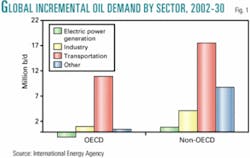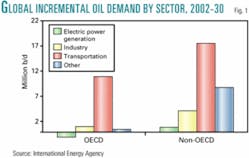Doris Leblond
The International Energy Agency released the 2004 edition of its World Energy Outlook Oct. 26 in what Executive Director Claude Mandil described as "an extremely unsettling environment" in which "the energy world has lost its bearings."
This year's WEO included analyses of high oil prices, the reliability of oil reserves data, and Russia's future as an "energy superpower" and offered an "alternative scenario" for a more sustainable energy world and a "hard look" at energy poverty.
While presenting the WEO, Mandil said he was "optimistic" that energy resources are adequate to meet the nearly 60% increase in demand expected between now and 2030. The demand increase amounts to 16.5 billion tonnes of oil equivalent (toe), three quarters of which will occur in developing countries (Fig 1).
"Moreover," he said, "there is more than enough money globally to finance the large expansion of energy infrastructure that will be needed." The WEO sets this financing at $16 trillion (in 2000 dollars) over the projected period, or $568 billion/year, marginally higher than the $550 billion reported in the 2003 WEO (Fig. 2).
Mandil's optimism, however, was tempered by "the symptoms of a considerable malaise in the world of energy." He pointed out the increasing vulnerability of energy supply routes and increasing emissions of carbon dioxide.
According to WEO's reference scenario, by 2030 fossil fuels will account for more than 90% of the world's energy demand growth and nearly all of the increase in the world's primary energy production. This rise is expected to occur outside the industrial countries represented by the Organization for Economic Cooperation and Development.
Demand estimates
According to the WEO, worldwide oil demand will grow 1.6%/year to 90 million b/d in 2010 from the current 82 million b/d and to 121 million b/d in 2030.
Demand for natural gas will nearly double to 4.9 trillion cu m over 2002-30, while coal use will increase by 50% to 7 billion tonnes by that time.
Demand for renewable sources of energy—including geothermal, solar, wind, tidal, and wave energy—will grow faster than any other energy source at 5.7%/year, but their share of world demand in 2030 will be only 2%. Nuclear power will grow slightly, decreasing in Europe and increasing in Asia.
Oil demand growth will be faster in developing countries, with the fastest-growing region being Africa at 3.4%/year. China's demand also will grow at 3.4%/year, well below the 11% increase in 2003.
Within OECD nations, oil demand will be relatively low at 0.8%/year. As a result, non-OECD countries' share of global oil demand will rise to just over 50% in 2030 from 39% in 2002.
Most of the worldwide increase in oil demand will come from the transportation sector. The continuing shift towards lighter transport fuels will call for new investment in secondary processing facilities in refineries, noted WEO.
There also will be rapid expansion of the worldwide capacity of gas-to-liquids plants, bringing a sharp increase in the supply of clean diesel.
Growing imports
All of the net oil-importing regions—most notably the three OECD regions and developing Asia—will become increasingly dependent on imports. The OECD's dependence will jump to 85% of total demand in 2030 from 63% in 2002. China's import dependence by 2030 will be 74%, its import rate 10 million b/d.
Most of the supply will come from the Middle East. Increased trade from that area will strengthen mutual dependence between exporting and importing countries.
It also will increase the world's vulnerability to a price shock induced by oil-supply disruptions. Much of the additional trade will involve routes at risk of sudden closure, such as the Straits of Hormuz, the Straits of Malacca, the Suez Canal, the Sumed pipeline, the Bab el-Mandab passage connecting the Red Sea and the Gulf of Aden, the Bosphorus and Turkish straits, the Panama Canal, the Druzhba pipeline carrying Russian oil to Europe, and the Baltic pipeline system.
Oil prices
Despite the WEO's assumption that oil prices will decline after peaking in 2004, world oil production will continue to rise to 121 million b/d in 2030 from 77 million b/d in 2002 and is not expected to peak before then if necessary investments are made.
Through 2010, producers outside the Organization of Petroleum Exporting Countries will contribute most of the increase, mainly in West Africa and Latin America, while Russian production should continue to rise, but at a slower rate, to 10.4 million b/d from about 9 million b/d in early 2004.
After 2010, OPEC production, especially from the Middle East, will increase more rapidly, with its share rising to 53% in 2030 from 37% in 2002. This is slightly above its 1973 historical peak.
However, higher oil prices will lower OPEC's market share by stimulating non-OPEC and nonconventional oil production. "Higher oil prices are profitable for exporting countries in the short term but lead to lower revenues in the long term," the report said.
Investments
To maintain and replace production, about $3 trillion will need to be invested in the oil sector from 2003 to 2030. Provided "investment is made at the right time in the right place," there are sufficient oil reserves to meet demand over the next 3 decades, Mandil noted.
But Mandil called on industry to work together to devise and implement a universally recognized, transparent, consistent, and comprehensive oil and gas reserves reporting system. Doubts about the accuracy of reserves estimates, he said, could undermine investor confidence and slow investment.
Gas demand
Global demand for gas will increase 2.3%/year, largely for electric power. Demand should grow fastest in Africa, Latin America, and developing Asia, yet the total volume increase will be bigger in the mature markets of OECD North America, Europe, and transitional economies. With proven reserves equal to about 66 years of production at current rates, global demand can be easily met, the study said.
Gas production will increase largely in Russia and the Middle East, which will export much of their incremental production to North America, Europe, and Asia.
Interregional gas trade will triple by 2030, and LNG will account for most of the increase. By 2030, more than half the interregional gas trade will be in the form of LNG, up from the current 30%. OPEC will continue to dominate LNG supply.
Investments of $2.7 trillion will be needed for gas-supply infrastructure to 2030, or about $100 billion/year, half of which will be absorbed by exploration and development of gas fields.
Gas prices, which have risen strongly on the back of oil prices in recent months, will subside in the second half of this decade then recover steadily through 2030.
Meanwhile, GTL plants are expected to emerge as a major new market for natural gas, using cheap reserves far from traditional markets.
CO2 emissions
The WEO gives much attention to an estimated 1.7%/year increase in global CO2 emissions over 2002-30. Nearly 70% of the increase will come from developing countries. Electric power generation will contribute half the increased emissions. By 2010, energy-related CO2 emissions will be 39% higher than in 1990 instead of stabilizing as required by the Kyoto Protocol on Climate Change.
Faced with these projections under what it calls the reference scenario, the WEO provides a world alternative policy scenario, which details how the energy future could be more efficient and environmentally benign if governments adopted policies they are either currently considering or that they might reasonably be expected to implement through 2003, together with faster deployment of technology.
In this scenario global energy demand is 10% lower in 2030, with oil demand 12.8 million b/d lower. This is equal to the current combined oil production of Saudi Arabia, the UAE, and Nigeria. Stronger fuel economy measures in OECD areas and faster deployment of more-efficient vehicles in non-OECD regions account for two thirds of the savings.
Coal demand falls a quarter below the reference scenario, and natural gas demand is 10% lower. Gas import needs are 40% lower in North America and 10% lower in Europe.
CO2 emissions would fall by 6 billion tonnes/year, or 16% below the reference scenario, roughly equal to the combined current emissions of the US and Canada.
OECD CO2 emissions peak in 2020. More efficient use of energy in a wide range of applications, including vehicles, electric appliances, lighting, and industry, accounts for 60% of the reduction, with a shift for electric power generation to renewables and nuclear accounting for most of the rest.


